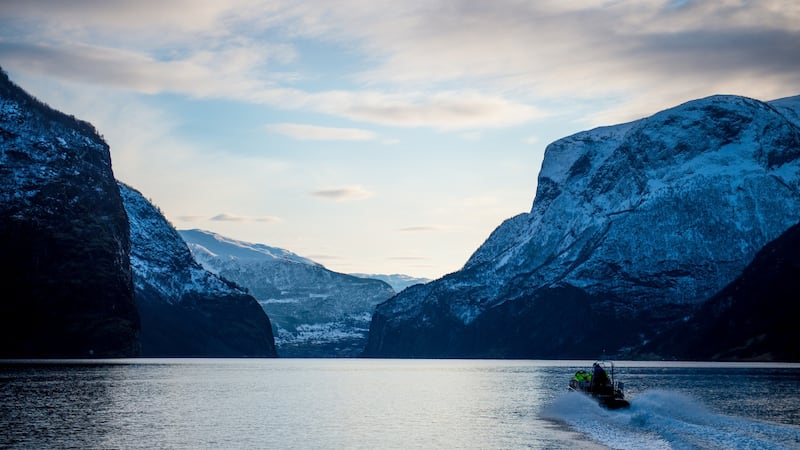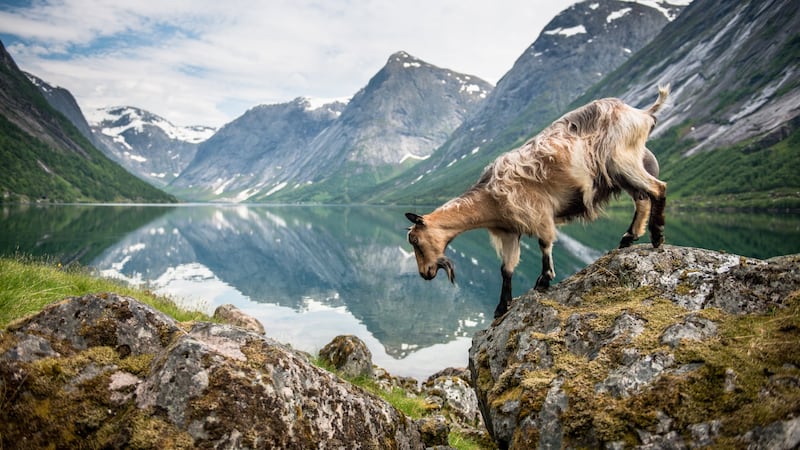How is it that a city so surrounded by, and engulfed in, water manages to burn to a cinder again and again over the centuries?
Fjord-smooching Bergen is doused in about 2.25m of rain a year. More than three times the rainfall of Dublin, for example, it was clearly not enough to quench over a dozen great fires that have gutted the Norwegian city since the 12th century.
Consequently, a “Bergenser” out of the rain is like a fish out of water, but don’t they wear it well?


Like walking-talking Helly Hansen fit models, the men are so all-weathered and virile-looking they might once have been breastfed cod liver oil, whereas the women mostly share the same aquatic-eyed, elf-faced aspect, as if conceived beneath some statuesque toadstool.
Norwegians play it straight, but not stiff.
You will see no rows of prefect-perfect pedestrians stacked upon the sidewalk of a deserted street, waiting for the little green man.
A contented people, in equal parts calm and quietly confident, most speak at least rudimentary English; long enough to reveal a dry, understated humour lacing much of their conversation, a few minutes in.
Melancholy
Founded in 1070 and translating as the "meadow among the mountains", west coast Bergen drove the nation's economic pulse until less than 200 years ago, when Oslo took over the throne.
It’s certainly not one of Europe’s most beautiful cities, but it’s far from unappealing – especially if perusing a pleasant day strolling the Bryggen (colourful, reconstructed Hanseatic buildings on the harbour), taking the cable car up Mount Fløyen (lording over the city centre) or exploring the worthy KODE arts museum buildings over a leisurely, saturated afternoon.
But the truth is that Bergen is best served as a portal to the surrounding fjord country, so much of which (including all of the following) can be accessed within a day’s journeying north from the city, via ferries, trains and motorways.
You could be forgiven for surmising that the cloud-choked Norwegian fjords are akin to New Zealand's South Island on Prozac, but it's only when sacred flashes of sunlight alight, your lips part in WOW at some of the most stunning scenery in Europe.
But most of the other time, the steep, densely wooded valleys cast beneath brooding Nordic skies imbue everything with a Munch melancholy.
About halfway along the deep, 180km-long Sognefjord is the beguiling town of Balestrand, set among some of the most painted mountainscapes in northern Europe.
Its notoriety began with the translation of the Icelandic saga Fritjof the Warrior in 1825, which helped spur a 19th century Nordic cultural revival, propelling landscape artists into places such as Balestrand.
Much like our own Celtic Renaissance, it helped spur a nationalist drive that climaxed in Norway's independence from Sweden in 1905.
Anti-ageist graffiti
The successful artists and writers created “dragon-style” houses across the orchard-strewn town: Palladian wooden villas in the misnomered “Swiss” style between the 1890s and 1920s.
Of its 1,400 inhabitants, the most eccentric is said to be a wealthy septuagenarian known as “The Elizabeth” who tags the town by night in anti-ageist graffiti.
Bolstered by the flow of North Sea oil money, Norway’s superb rural infrastructure would put most nations to shame in the unfailing quality of its roads and railways (and their multitude of multi-mile tunnels), ferry services and public lighting, and the supply of electricity, broadband, social services and economic investment to the furthest flung of Norway’s nether regions.
The poster child of that infrastructure is the 18 National Tourist routes that lattice the spine of the country – 10 of which criss-cross fjord country. The routes urge you to get out and smell the roses, or indulge in any of the many well-flagged loop walks and nature trails shooting from them.
They also parade vanguard viewing points and rest areas showcasing that post-modern groove where minimalist Scandinavian architecture, engineering, landscape architecture and land art meet to moonlight as portals to regional culture, history and nature.
On the Gaularfjellet National Tourist Route, the Utsikten (“The View”) viewing platform opened last summer to the tune of €2 million, marketed in spin-free Nordy-speak as a “large triangular concrete slab with corners that are bent upwards”.
Perched on the lip of a mountain, it’s certainly that and much more besides: a tribute to Norwegian design and resolve.
South of Gaularfjellet is the Aurlandsfjellet National Tourist Route. This is Jølster, where grass-roofed, Hansel and Gretel-style houses built over several centuries dot the roadside as bell-braced ewes wander the mountains through summer.
Salmon-laden rivers spill down mountainsides in a Valhalla of white water frenzy. The Stegastein viewing point also offers jaw-dropping scenery atop of a cutting-edge platform akin to some inverted ski-jump of wood, concrete and glass.
Across the valley floor squat placid lakesides along which generations of smallholders have raised the hemline between the water and the woods to reveal bountiful paddocks; places where petite, white, wooden churches signal villages with Volvos and Audis galore.
In higher terrain, between rowan, birch and pine, boulders are draped in sphagnum, moss and fern.
Naturalism
On the south side of Jølstravatnet fjord rests Astruptunet , home of painter, illustrator and graphic artist Nikolai Astrup (1880-1928), one of the country's most renown artists.
Inspired by the shifting weather patterns and light and mountains of Jølster, Astrup’s uncomplicated naturalism seems fittingly Norwegian.
Dying of pneumonia at just 47, for the last 15 years of his life Astrup lived and worked with his large young family at these Hobbit-esque, earth-roofed timber buildings and gardens, nestled into a terraced hillside overlooking a ghostly fjord.
His artwork remains largely unknown outside his own nation, but Norwegians seem to agree that this sleeping giant is soon to awaken.
Having stayed the night in tranquil Marifjøra on Sognefjord, we cross the fjord by ferry to the Urnes Stave Church, a Unesco World Heritage site, which dates from 1130.
A medieval, wooden church building, once littered about north-western Europe, the stave (or upright) church style ceased in 1350 with the arrival of the Black Death in Norway.
To step into such a church is to breathe in muffled centuries of worship, witness and history. It’s all about the wood, which almost seems animate and conscious compared to the unyielding, stoic stone of our own Irish churches.
Urnes is the oldest preserved stave church in the world – of more than 1,000 originally, less than 30 survive; its dark wood and ornate carvings are thought to have been inspired by the Book of Kells.
Thunderous waterfalls
At about 2,000m high, the Bøyabreen glacier in Fjærland is also worth a detour, after which call in to the thought-provoking, if somewhat dated, Norwegian Glacier Museum, which covers the world of ice, glaciers and their role in the Earth’s evolution and pending climate change.
Arcing south for the slow, rewarding journey back to Bergen, the hour-long Flåm Line Railway serves as an exhibition of thunderous waterfalls thoughtfully laid out between Heidi-esque chalets and sloping pastures, as the rail line plays peek-a-boo between a checklist of tunnels.
Ascending the valley of Flåmsdalen, where mythical huldra (earthy sirens that lured men into the woods to meet their end) were said to have resided, the scenery could serve as a B movie Norwegian alternative to The Sound of Music.
The train stops at one gargantuan waterfall and after we step out, recorded music pounds out as a blonde huldra emerges from the drizzle in a red silken gown, high up the hanging valley, and pulling dance moves like some confused love child of Wonder Woman and Eric the Viking.
I suspect her idea of foreplay would be a headlock. We soon pile back on the train and I giggle all the way back to Bergen.
How to visit Bergen...
Flights: Dublin-Bergen flights are available from about €115 return.
Currency: At time of writing, €1 will get you 9.12 Norwegian kroner (NOK). All prices below are in NOK valid for 2016.
Accomodation:
Bergen: Thon Hotel Bergen Brygge – from NOK995 per double room per night/two persons, including breakfast.
thonhotels.no/hoteller/land/norge/bergen/thon-hotel-bergen-brygge/
Balestrand: Kviknes Hotel – from NOK1,750 per double room per night/two persons, including breakfast, kviknes.com/
Marifjøra: Tørvis Hotel – from NOK1,850 per double room, torvis.no/home
Transportation:
Express boat: Bergen – Balestrand, NOK580 per person (duration 3 hours 50 mins), norled.no/en/
Train: Flåm - Bergen from NOK 589-640 per person, nsb.no/forside
Fjord Tours offers different packages including train, boat and bus in the Sognefjorden area, fjordtours.com/
For further information, visit: fjordnorway.com, visitnorway.com and nasjonaleturistveger.no/en










